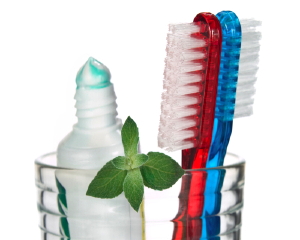What’s the Best Toothpaste?
 Simple Science: The Best Toothpaste
Simple Science: The Best Toothpaste
In the wide and confusing world of popular tooth cleansing products undoubtedly the safest, most effective combination you can use on your teeth is a soft bristle toothbrush and water, twice a day for at least two minutes at a time. Back up this simple exercise by flossing at least once a day, without fail — and you will have the healthiest mouth around.
But realistically most of us who are interested in maintaining a healthy oral environment probably will feel slightly dissatisfied with the notion that you can have clean teeth without using minty commercial toothpaste. So, what are the healthiest options and how can you make sure you are using products that promote clean teeth and preserve your overall good health?
It’s All In the Ingredients
When you consider that Ben Franklin used a combination of honey and ground charcoal to clean his teeth, it becomes fairly evident that people have been concerned with keeping their teeth clean for a very long time and over the course of time; there has been quite a few interesting ways of accomplishing the important feat of good oral hygiene.
Take for example an ancient Egyptian recipe discovered in 2003 dating back more than 1,500 years that combined one drachma of rock salt – (approximately 100th of an ounce) – two drachmas of mint, one drachma of dried iris flower and 20 grains of pepper all carefully crushed and mixed together to form the best known “powder for white and perfect teeth”. Modern scholars daring enough to try the concoction for themselves found it ‘abrasive and painful to use’. And so … it’s no doubt why we’ve been looking for better alternatives ever since.
Ingredients to Avoid
The most common ingredients in toothpaste include; Silica and Limestone, Aluminum Oxide (provides coarseness to scrubbing) Titanium Dioxide (made from the minerals ilmenite, rutile and anatase – to give toothpaste its white pigment), Mica (adds sparkle to the toothpaste) and of course, fluoride.
For many of the ingredients in toothpaste there are potential health concerns and some have proven to be downright toxic. Some of the biggest offending chemicals include the following:
Fluoride: a byproduct of the fertilizer industrial – this toxic chemical can cause a myriad of health problems when ingested (usually as an additive of the public water systems) and, ironically it is a known demineralizer that removes calcium from teeth and bones causing discolorization of teeth leaving them brittle.
Saccharin and other artificial sweeteners: People ingest synthetic sweeteners and don’t realize how harmful it can be to their health, much less their teeth. A good rule of thumb is to avoid any artificial ingredients in your toothpaste, particularly in the form of sweeteners.
Sodium Lauryl Sulfate (SLS) and other detergents: used in many known products as a foaming agent and as with most detergents SLS is known to be harmful to the skin, eyes, brain, liver and lungs. It is also quite corrosive and harmful to skin tissue. SLS is also widely used in garage floor cleaners, engine degreasers and car wash soaps.
Aluminum: when combined with fluoride, aluminum is absorbed into the body at an alarming rate, and aluminum is a metal that seems to collect in the brains of Alzheimer’s victims.
Silica or Zirconium: an abrasive mineral – harms gums and wears away tooth enamel which is particularly hazardous for people who brush a little too enthusiastically or when combined with hard bristle toothbrushes.
Healthy Alternatives
Everyone is looking for a healthy alternative, so what’s the best toothpaste? What’s the best alternative? The fact is, each and every person reacts differently to different ingredients. Take for instance, the case of a recent patient of ours: she had been recommended a bee propolis toothpaste which, by most accounts, is a very biocompatible toothpaste. She broke out into blisters along her guns (and no, she is not allergic to bees). Even within our office we have different employees who are sensitive to different toothpastes. The choice of one employee actually causes dry mouth in another employee. So what’s the best toothpaste for you? You’ll have to learn the ingredients and try different types until you find one that you are most compatible with.
Mixing Up the Homemade Pastes
An online search will turn up hundreds of recipes for toothpaste, and most of those at least start with the two basic ingredients of hydrogen peroxide and baking soda. For anyone interested in trying their own hand at making homemade toothpaste just keep in mind that you want to avoid anything that might be overly abrasive to tooth enamel or harmful to the gums, and never swallow the ingredients.
For its recognized healing properties, Aloe Vera is a good ingredient to include as is diluted tea tree oil but most recipes focus on taste and giving a lasting sense of freshness to the mouth. Some of those ingredients include cinnamon, ginger, fennel, clove, spearmint and peppermint – all relatively harmless when combined with other dry ingredients but stay away from essential oil versions of these flavors unless they are well diluted as they can cause burning sensations to the mouth and gums.
Store Bought Toothpastes
There is an unending list of toothpastes on the market today, some claiming to be ‘natural’ while still including ingredients that are either on our list of things to avoid or chemicals that cannot be pronounced. The bottom line is; avoid any toothpaste that has more than six or seven ingredients and never buy anything that contains chemicals or ingredients that you cannot identify. Look for toothpastes that do not contain fluoride, aluminum, artificial sweeteners or detergents and beware of toothpaste marked ‘natural’ – do your homework and read the label.
Toothpaste Analysis
To help make your decision easier (or maybe more difficult) we have compiled a list of many of the most popular alternative toothpaste options. We have done our best to provide complete analysis, but as formulas change, this list may become out of date. Hopefully it provides a starting point for you in your search.
Enjoy… and good luck!
